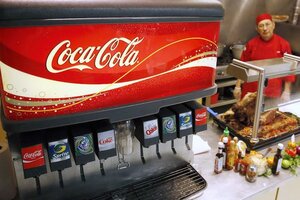Ads for junk food and soda target minorities more than whites, study finds
A new study shows that companies selling soda and other high-calorie foods are pouring millions into ads meant for minority viewers.

A soft drink vending machine is seen in a cafeteria in Boston, Saturday, March 22, 2014.
Michelle Dwyer/AP/File
Black and Hispanic kids are disproportionately targeted by marketing campaigns selling sodas and other sugary, high-calorie foods, according to a new research report revealed Tuesday.
Researchers have long suspected a link between targeted marketing and relatively higher levels of obesity in African American and Hispanic youth, compared with their white or Asian American peers. Now, a study released by the Rudd Center for Food Policy & Obesity at the University of Connecticut, the African American Collaborative Obesity Research Network (AACORN), and Salud America demonstrates that companies selling candy, soda, and other “junk food” are pouring millions into ads meant for minority viewers.
“The job of food companies is to sell products, regardless of the effects...If they can sell to minority populations, why wouldn’t they want to?” asks Marion Nestle, Paulette Goddard Professor of Nutrition, Food Studies, and Public Health at New York University in an e-mail to the Monitor.
“Minority and low-income populations can afford to buy junk foods and such foods are widely available in their communities,” she adds.
While conducting their study, the researchers analyzed 26 restaurants, food, and beverage companies, including all companies that spent over $100 million in 2013. They also sifted through company reports and press releases to identify statements about targeted marketing practices, used market research data to identify brands with television advertising targeted at black and Hispanic audiences, and examined data for the 267 most-advertised brands. The results demonstrated the extent to which many companies specifically market their products to minority populations.
Companies were especially candid about their efforts to target Spanish-speaking populations, the researchers found.
“Statements about targeted marketing primarily focused on the growing and increasingly important Hispanic consumer. Some beverage companies also noted their strategy to reach ‘multicultural’ millennials through sponsorships and events,” the report notes. “In addition, many of the large packaged-food companies maintained Spanish-language versions of their websites, and one fast-food company (McDonald’s) offered separate websites for Black, Hispanic, and Asian American consumers.”
Seven companies, including Post Foods, Dr Pepper, Snapple Group, Wendy’s, 3G Capital, Kraft Foods, and Kellogg, spent 10 percent of their total TV advertising budgets on Spanish language programming. Candy maker Mars, meanwhile, spent 23.5 percent of its budget on Spanish-language television.
Meanwhile, brands including, 7Up, Kraft Mayonnaise, and Fuze Ice Tea did not advertise on English-language television at all.
Conversely, only three companies openly discussed their plan to target black consumers: Coca-Cola, General Mills, and McDonald’s. Nevertheless, most of the companies analyzed placed ads on television networks that target black viewers, spending around $161 million and representing around three-quarters of all food-related ads on those networks. Meanwhile, more than half of the companies in the study spent over $100,000 on television networks with a high proportion of black viewers.
Candy and gum companies had especially high rates of targeting minority consumers.
“Candy brands represented 9.4% of all TV advertising spending for food-related brands, but this category contributed 13.3% of food-related spending on Spanish-language TV and 18.3% of spending on Black-targeted TV,” the report notes.
The data reveals that black children and teens saw at least twice as many ads for gum and soda as their white peers, and around 70 percent more food-related TV commercials.
The authors of the study were quick to note that marketing a product to appeal to a specific demographic is not in itself problematic, but public health advocates argue that it can become questionable when disparities between different populations are taken into account. Numerous studies have shown that Americans are gaining more and more weight, and minorities are diagnosed with obesity more frequently than other groups.
According to data from the US Department of Health and Human Services Office of Minority Health, African Americans were 1.5 times as likely to be considered obese as Non- Hispanic Whites in 2011. Data also showed that African American women were 80 percent more likely to be diagnosed as obese than non-Hispanic white women.
“This is a clear case of tactics that must be profitable from the business perspective but at the cost of fostering an environment that promotes poor health in black and Hispanic youth in particular," Shiriki Kumanyika, Chair of the African American Collaborative Obesity Research Network, which studies obesity among black Americans, told NBC News in relation to the study’s findings.
Although it's difficult to prove that advertising directly causes people to eat too much junk food, how companies advertise reflects and reinforces preferences, the researchers noted.
“Public health advocacy campaigns should focus on improving marketing practices of companies that currently allocate disproportionately more of their advertising budgets to market unhealthy products to Black and Hispanic youth,” they then recommended.
And some experts agree that such efforts are needed.
“Public health advocacy focuses on education, but also on trying to obtain policies to improve the environment of food choice—soda taxes are a good example,” says Dr. Nestle.
“Mrs. Obama’s Let’s Move! campaign has the goals of putting healthier foods into inner cities and other low-income areas and improving food in schools—both important methods for providing healthier options to minority and low-income communities,” she adds.

